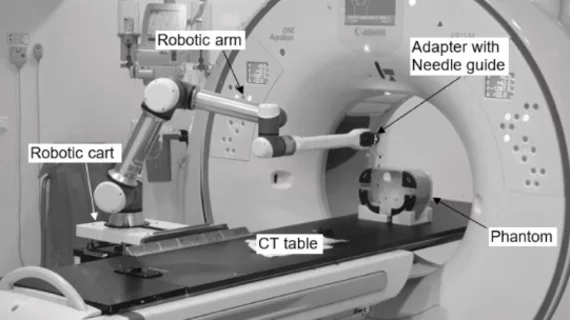Robot-assisted needle positioning in CT-guided procedures improves accuracy, reduces repeats
Robotic assistance for needle positioning during CT-guided biopsy increases accuracy without increasing procedure times.
Compared to freehand techniques during procedures requiring needle positioning, robot assistance results in fewer adjustments, even for seasoned interventional radiologists. That’s according to a new study published in the European Journal of Radiology that compares the overall performances of the two techniques.
Robot assistance has the potential to increase accuracy, expedite procedures and reduce radiation exposure. However, there are added factors that need to be considered alongside its use, like installation, sterilization and costs. These factors can vary widely based on the type of system used, corresponding author of the paper Jan Heidkamp, with the Department of Medical Imaging at Radboud University Medical Center in the Netherlands, and colleagues explained.
For this study, experts used ANT-C—a system designed to plan needle trajectory and orient physicians to insert needles manually with great accuracy. It is not a floor-mounted system, so it can be used with any CT scanner; it also can help position multiple needles based on just one scan.
Using an abdominal phantom, experts compared robot-assisted needle placements to those delivered by one interventional radiology fellow and one experienced interventional radiologist. A total of 12 positionings were included in the analysis.
Experts found that the robot system improved the amount of successful needle targets (20/24 vs 14/24), achieved higher accuracy and required fewer adjustments in comparison to freehand positioning. Procedure times did not differ greatly between the two methods (19.5 ± 9.2 minutes with robotic assistance vs. 21.0 ± 6.9 minutes freehand).
Although the fellow benefited more from assistance, the robotic system improved the performance of both providers.
The authors note that use of the ANT-C system is technically feasible and appears to hold promise for clinical settings, but more research is needed to determine whether robotic assistance can improve outcomes and how it affects radiation dose in human patients.
The study abstract is available here.

